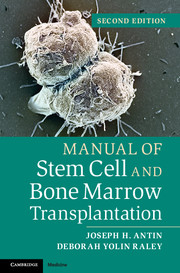Book contents
- Frontmatter
- Contents
- Acknowledgments
- Contributor
- 1 Rationale for transplantation
- 2 Types of transplantation
- 3 Human leukocyte antigen matching in allogeneic transplantation
- 4 Stem cell source
- 5 Pretransplant evaluation and counseling of patient and donor
- 6 Conditioning regimens
- 7 Stem cell infusion
- 8 ABO compatibility
- 9 Engraftment
- 10 Preventative care
- 11 Transplant-related complications
- 12 Overview of acute and chronic graft-versus-host disease
- 13 Acute graft-versus-host disease and staging
- 14 Graft-versus-host disease prophylactic regimens
- 15 Treatment guidelines for acute graft-versus-host disease
- 16 Chronic graft-versus-host disease
- 17 Engraftment syndrome
- 18 Infectious disease
- 19 Graft rejection and failure
- 20 Gastrointestinal complications
- 21 Oral health in stem cell transplantation
- 22 Pulmonary complications
- 23 Veno-occlusive disease
- 24 Special transfusion-related situations
- 25 Cardiovascular complications
- 26 Neurologic complications
- 27 Cystitis
- 28 Donor lymphocyte infusion
- 29 Transplantation: regulation and accreditation
- Index
29 - Transplantation: regulation and accreditation
Published online by Cambridge University Press: 05 November 2013
- Frontmatter
- Contents
- Acknowledgments
- Contributor
- 1 Rationale for transplantation
- 2 Types of transplantation
- 3 Human leukocyte antigen matching in allogeneic transplantation
- 4 Stem cell source
- 5 Pretransplant evaluation and counseling of patient and donor
- 6 Conditioning regimens
- 7 Stem cell infusion
- 8 ABO compatibility
- 9 Engraftment
- 10 Preventative care
- 11 Transplant-related complications
- 12 Overview of acute and chronic graft-versus-host disease
- 13 Acute graft-versus-host disease and staging
- 14 Graft-versus-host disease prophylactic regimens
- 15 Treatment guidelines for acute graft-versus-host disease
- 16 Chronic graft-versus-host disease
- 17 Engraftment syndrome
- 18 Infectious disease
- 19 Graft rejection and failure
- 20 Gastrointestinal complications
- 21 Oral health in stem cell transplantation
- 22 Pulmonary complications
- 23 Veno-occlusive disease
- 24 Special transfusion-related situations
- 25 Cardiovascular complications
- 26 Neurologic complications
- 27 Cystitis
- 28 Donor lymphocyte infusion
- 29 Transplantation: regulation and accreditation
- Index
Summary
Governmental regulations existat both the federal and state level. At the federal level, the US Food andDrug Administration (FDA) is responsible for enforcing the regulations forhuman cells, tissues, and cellular- and tissue-based products. Cellularproducts are regulated under either cGTP 21CFR 1271, cGMP 21 CFR 210, or inpart under the device regulations. Cell therapy products that are more thanminimally manipulated (including all gene therapy products) most often needan FDA IND exemption and at least Institutional Review Board (IRB) approvalbefore use. Some states have developed licensure processes, certificateprograms, and so on, but other states have few specific regulations.
There are three voluntaryprofessional organizations that set standards and accredit variouscomponents of hematopoietic stem cell transplantation (HSCT). The threefoundations are the Foundation for the Accreditation of Cellular Therapy(FACT), the American Association of Blood Banks (AABB), and the NationalMarrow Donor Program (NMDP).
The Foundation for theAccreditation of Cellular Therapy is a partnership between twoorganizations, one based on clinical outcome while the other is laboratorybased. In concert, they provide minimal guidelines and standards to allsources and phases for facilities and individuals who perform HSCT. It isimportant to know your program’s specific regulations under FDA, state, andother voluntary accredited programs.
- Type
- Chapter
- Information
- Publisher: Cambridge University PressPrint publication year: 2013

